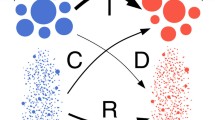Abstract
The paper proposes and investigates a new index of flow autocorrelation, based upon a generalization of Moran’s I, and made of two ingredients. The first one consists of a family of spatial weights matrix, the exchange matrix, possessing a freely adjustable parameter interpretable as the age of the network, and controlling for the distance decay range. The second one is a matrix of chi-square dissimilarities between outgoing or incoming flows. Flows have to be adjusted, that is their diagonal part must first be calibrated from their off-diagonal part, thanks to a new iterative procedure procedure aimed at making flows as independent as possible. Commuter flows in Western Switzerland as well as migration flows in Western US illustrate the statistical testing of flow autocorrelation, as well as the computation, mapping and interpretation of local indicators of flow autocorrelation. We prove the present dyadic formalism to be equivalent to the “origin-based” tetradic formalism found in alternative studies of flow autocorrelation.





Similar content being viewed by others
Notes
Other possible choices such as \(\delta _i=(WB)_{ii}/\varDelta \), where B is the matrix of scalar products associated to D, will be discussed in a forthcoming publication.
Data available at https://github.com/christiankaiser/flowdata.
References
Anselin L (1995) Local indicators of spatial association—LISA. Geogr Anal 27:93–115
Bavaud F (1998) Models for Spatial Weights: A Systematic Look. Geographical Analysis 30:153–171
Bavaud F (2013) Testing spatial autocorrelation in weighted networks: the modes permutation test. J Geogr Syst 15:233–247
Bavaud F (2014) “Spatial weights: constructing weight-compatible exchange matrices from proximity matrices”. In: Duckham M. et al. (Eds.): GIScience 2014, LNCS 8728, pp. 81–96. Springer
Behrens K, Ertur C, Koch W (2012) Dual gravity: using spatial econometrics to control for multilateral resistance. J Appl Econom 27:773–794
Berger J, Snell JL (1957) On the concept of equal exchange. Behav Sci 2:111–118
Berglund S, Karlström A (1999) Identifying local spatial association in flow data. J Geogr Syst 1:219–236
Bishop YM, Fienberg SE, Holland PW (1975) Discrete multivariate analysis: theory and practice. The MIT Press, Cambridge
Bivand RS, Pebesma EJ, Gómez-Rubio V, Pebesma EJ (2008) Applied spatial data analysis with R. Springer, New York
Black WR (1992) Network autocorrelation in transportation network and flow systems. Geogr Anal 24:207–222
Black WR, Thomas I (1998) Accidents on Belgiums motorways: a network autocorrelation analysis. J Trans Geogr 6:23–31
Bolduc D, Laferriere R, Santarossa G (1995) Spatial autoregressive error components in travel flow models: an application to aggregate mode choice. In: Anselin L, Florax RJ (eds) New directions in spatial econometrics. Springer, Berlin, pp 96–108
Brandsma AS, Ketellapper RH (1979) A biparametric approach to spatial autocorrelation. Environ Plan A 11:51–58
Chung FRK (1997) Spectral graph theory. AMS, Providence
Cover T, Thomas J (1991) Elements of information theory. Wiley, Hoboken
Cliff AD, Ord JK (1981) Spatial processes. Pion, Thousand Oaks
Fischer MM, Griffith DA (2008) Modeling spatial autocorrelation in spatial interaction data: an application to patent citation in the European Union. J Reg Sci 48(5):969–989
Hillberry R, Hummels D (2008) Trade responses to geographic frictions: a decomposition using micro-data. Eur Econ Rev 52:527–550
Kondor RI, Lafferty J (2002) Diffusion kernels on graphs and other discrete input spaces. In: ICML, vol 2, pp 315–322
LeSage J, Pace RK (2008) Spatial econometric modeling of origin-destination flows. J Reg Sci 48:941–967
LeSage J, Polasek W (2008) Incorporating transportation network structure in spatial econometric models of commodity flows. Spatial Econ Anal 3:225–245
Llano-Verduras C, Minondo A, RequenaSilvente F (2011) Is the border effect an artefact of geographical aggregation? World Econ 34:1771–1787
Polasek W, Sellner R (2010) Spatial Chow–Lin methods for data completion in econometric flow models (No. 255). Reihe Ökonomie/Economics Series, Institut für Höhere Studien (IHS)
Tiefelsdorf M, Braun G (1999) Network autocorrelation in poisson regression residuals: inter-district migration patterns and trends within Berlin. In: paper presented at the 11th European colloquium on quantitative and theoretical geography, Durham City, England, September 3–7
Author information
Authors and Affiliations
Corresponding author
Appendix: Computational details of diagonal flow adjustment
Appendix: Computational details of diagonal flow adjustment
Define a family of independent flows by the model distribution \(p^{ \text{ theo }}_{ij}=\beta _i\gamma _j\) where \(\beta \) and \(\gamma \) are unknown distributions. The free parameters are estimated so as the relative complete flows p, of the form (7) \(p_{ij}=\sigma _i\, \delta _{ij}+\mu \, a_{ij}\), is as close as possible from independent relative flows \(p^{ \text{ theo }}\), in the sense that the Kullback–Leibler divergence or relative entropy
must be minimum, under the constraints
Setting to 0 the derivative by \(\sigma _i\) yields with \(\mu =1-\sigma _{\bullet }\) :
where \(K(a || \beta \gamma ):=\sum _{ij}a_{ij}\ln \frac{a_{ij}}{\beta _i\gamma _j}\) is the “movers” relative entropy, which, incidentally, also appears in the likelihood ratio of the so-called quasi-independence models (e.g., Bishop et al. 1975). Derivating w.r.t. \(\beta _i\) under the constraint \(\sum _i \beta _i=1\) (and multiplier \(\lambda \)) yields
in view of \(\sigma _{\bullet }+\mu =1\). Hence \(\beta _i=\sigma _i+\mu a_{i\bullet }\). Similarily, \(\gamma _j=\sigma _j+\mu a_{\bullet j}\). Finally,

where \(a_{ij}=m_{ij}/m_{\bullet \bullet }\) is the known proportion of movers from i to j Sect. 2.4, from which the unknown \(\sigma ,\mu , \beta ,\gamma \) are to be estimated.
Equations (11) is iteratively solved from some initial solution such as \(\beta ^0_i=a_{i\bullet }\), \(\gamma ^0_j=a_{\bullet j}\) and \(\sigma _i^0=a_{i\bullet }a_{\bullet i}\) until convergence, which occurs provided \(a_{i\bullet }>0\) and \(a_{\bullet j}>0\) for all origins i and destinations j. If needed, the latter conditions can be insured by considering augmented flows \(t_{ij}+1\) instead of \(t_{ij}\), a choice adopted for convenience in the case studies of Sect. 3, and justifiable in a Bayesian framework (Laplace rule of succession).
More generally, \(a_{i\bullet }+a_{\bullet i}=0\) makes i irrelevant (a “non-region”). \(a_{i\bullet }=0\) and \(a_{\bullet i}>0\) makes \(\beta _i=\sigma _i=0\) (absorbing destination). Similarly, \(a_{i\bullet }>0\) and \(a_{\bullet i}=0\) makes \(\gamma _i=\sigma _i=0\) (transient origin). Finally, \(a_{i\bullet }+a_{\bullet i}>0\) and \(a_{i\bullet }a_{\bullet i}=0\) for all i splits the regions between two non-intersecting sets, namely transient origins and absorbing destinations, with \(\sigma _{\bullet }=0\) and \(\mu =1\), characterizing incommensurate, “rectangular” flows.




